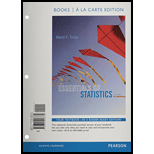
Benford’s Law. According to Benford’s law, a variety of different data sets include numbers with leading (first) digits that follow the distribution shown in the table below. In Exercises 21–24, test for goodness-of-fit with the distribution described by Benford’s law.
| Leading Digit | 1 | 2 | 3 | 4 | 5 | 6 | 7 | 8 | 9 |
| Benford’s Law: Distribution of Leading Digits | 30.1% | 17.6% | 12.5% | 9.7% | 7.9% | 6.7% | 5.8% | 5.1% | 4.6% |
23. Tax Cheating? Frequencies of leading digits from IRS tax files are 152, 89, 63, 48, 39, 40, 28, 25, and 27 (corresponding to the leading digits of 1, 2, 3, 4, 5, 6, 7, 8, and 9, respectively, based on data from Mark Nigrini, who provides software for Benford data analysis). Using a 0.05 significance level, test for goodness-of-fir with Benford’s law. Does it appear that the tax entries are legitimate?
Trending nowThis is a popular solution!

Chapter 11 Solutions
Essentials of Statistics, Books a la Carte Edition (5th Edition)
- For context, the image provided below is a quesion from a Sepetember, 2024 past paper in statistical modelingarrow_forwardFor context, the images attached below (the question and the related figure) is from a january 2024 past paperarrow_forwardFor context, the image attached below is a question from a June 2024 past paper in statisical modelingarrow_forward
- For context, the images attached below are a question from a June, 2024 past paper in statistical modelingarrow_forwardFor context, the images attached below (question and related graph) are from a February 2024 past paper in statistical modelingarrow_forwardFor context, the images attached below are from a February 2024 past paper in statistical modelingarrow_forward
- For context, the image provided below is a question from a September, 2024 past paper in statistical modelingarrow_forwardFor context, the image below is from a January 2024 past paper in statistical modelingarrow_forwardFor context, the image provided below is a question from a September, 2024 past paper in statistical modelingarrow_forward
- Section 2.2 Subsets 71 Exercise Set 2.2 Practice Exercises In Exercises 1-18, write or in each blank so that the resulting statement is true. 1. {1, 2, 5} {1, 2, 3, 4, 5, 6, 7} 2. {2, 3, 7} {1, 2, 3, 4, 5, 6, 7} 3. {-3, 0, 3} {-4,-3,-1, 1, 3, 4} 4. {-4, 0, 4} 5. {Monday, Friday} {-3, -1, 1, 3} {Saturday, Sunday, Monday, Tuesday, Wednesday} 6. {Mercury, Venus, Earth} {Venus, Earth, Mars, Jupiter} 7. {x/x is a cat} {xx is a black cat} {x|x is a pure-bred dog} ibrary mbers, ause the entire sual 8. {xx is a dog} 9. (c, o, n, v, e, r, s, a, t, i, o, n} {v, o, i, c, e, s, r, a, n, t, o, n} 10. [r, e, v, o, l, u, t, i, o, n} {t, o, l, o, v, e, r, u, i, n} 33. A = {x|x E N and 5 < x < 12} B = {x|x E N and 2 ≤ x ≤ 11} A_ B 34. A = {x|x = N and 3 < x < 10} B = A. {x|x = N and 2 ≤ x ≤ 8} B 35. Ø {7, 8, 9,..., 100} 36. Ø _{101, 102, 103, . . ., 200} 37. [7, 8, 9,...} 38. [101, 102, 103, ...} 39. Ø 40. { } { } e In Exercises 41-54, determine whether each statement is true or false. If…arrow_forwardA = 5.8271 ± 0.1497 = B 1.77872 ± 0.01133 C=0.57729 ± 0.00908 1. Find the relative uncertainty of A, B, and C 2. Find A-3 3. Find 7B 4. Find A + B 5. Find A B-B - 6. Find A * B 7. Find C/B 8. Find 3/A 9. Find A 0.3B - 10. Find C/T 11. Find 1/√A 12. Find AB²arrow_forwardWhy charts,graphs,table??? difference between regression and correlation analysis.arrow_forward
 Glencoe Algebra 1, Student Edition, 9780079039897...AlgebraISBN:9780079039897Author:CarterPublisher:McGraw Hill
Glencoe Algebra 1, Student Edition, 9780079039897...AlgebraISBN:9780079039897Author:CarterPublisher:McGraw Hill Big Ideas Math A Bridge To Success Algebra 1: Stu...AlgebraISBN:9781680331141Author:HOUGHTON MIFFLIN HARCOURTPublisher:Houghton Mifflin HarcourtAlgebra & Trigonometry with Analytic GeometryAlgebraISBN:9781133382119Author:SwokowskiPublisher:Cengage
Big Ideas Math A Bridge To Success Algebra 1: Stu...AlgebraISBN:9781680331141Author:HOUGHTON MIFFLIN HARCOURTPublisher:Houghton Mifflin HarcourtAlgebra & Trigonometry with Analytic GeometryAlgebraISBN:9781133382119Author:SwokowskiPublisher:Cengage Holt Mcdougal Larson Pre-algebra: Student Edition...AlgebraISBN:9780547587776Author:HOLT MCDOUGALPublisher:HOLT MCDOUGAL
Holt Mcdougal Larson Pre-algebra: Student Edition...AlgebraISBN:9780547587776Author:HOLT MCDOUGALPublisher:HOLT MCDOUGAL



